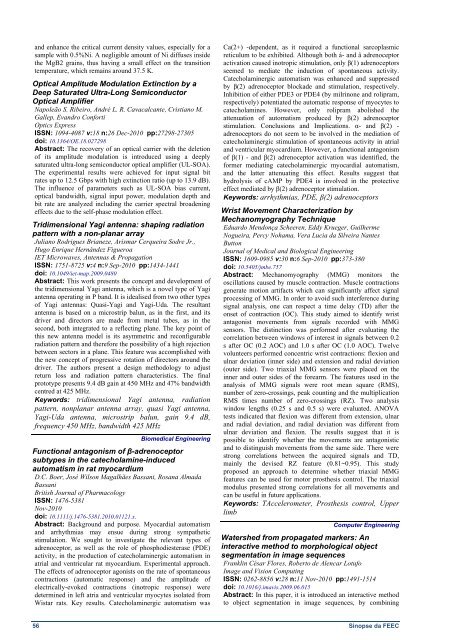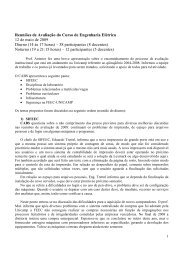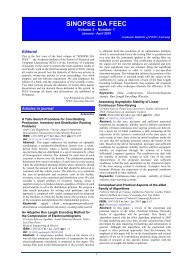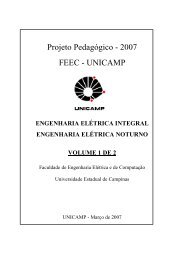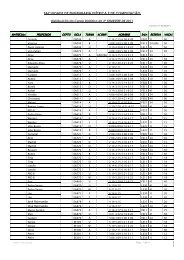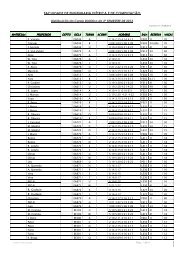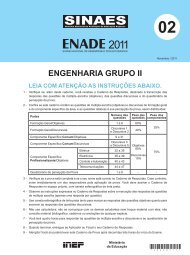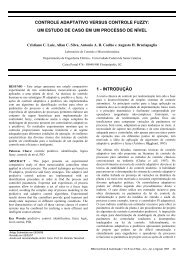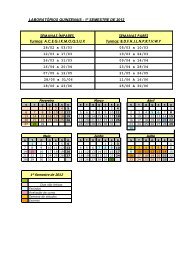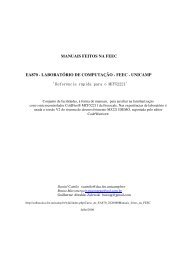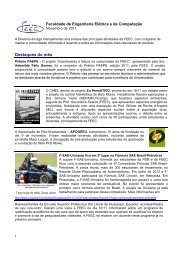sinopseV3n3.pdf - FEEC - Unicamp
sinopseV3n3.pdf - FEEC - Unicamp
sinopseV3n3.pdf - FEEC - Unicamp
Create successful ePaper yourself
Turn your PDF publications into a flip-book with our unique Google optimized e-Paper software.
and enhance the critical current density values, especially for a<br />
sample with 0.5%Ni. A negligible amount of Ni diffuses inside<br />
the MgB2 grains, thus having a small effect on the transition<br />
temperature, which remains around 37.5 K.<br />
Optical Amplitude Modulation Extinction by a<br />
Deep Saturated Ultra-Long Semiconductor<br />
Optical Amplifier<br />
Napoleão S. Ribeiro, André L. R. Cavacalcante, Cristiano M.<br />
Gallep, Evandro Conforti<br />
Optics Express<br />
ISSN: 1094-4087 v:18 n:26 Dec-2010 pp:27298-27305<br />
doi: 10.1364/OE.18.027298<br />
Abstract: The recovery of an optical carrier with the deletion<br />
of its amplitude modulation is introduced using a deeply<br />
saturated ultra-long semiconductor optical amplifier (UL-SOA).<br />
The experimental results were achieved for input signal bit<br />
rates up to 12.5 Gbps with high extinction ratio (up to 13.9 dB).<br />
The influence of parameters such as UL-SOA bias current,<br />
optical bandwidth, signal input power, modulation depth and<br />
bit rate are analyzed including the carrier spectral broadening<br />
effects due to the self-phase modulation effect.<br />
Tridimensional Yagi antenna: shaping radiation<br />
pattern with a non-planar array<br />
Juliano Rodrigues Brianeze, Arismar Cerqueira Sodre Jr.,<br />
Hugo Enrique Hernández Figueroa<br />
IET Microwaves, Antennas & Propagation<br />
ISSN: 1751-8725 v:4 n:9 Sep-2010 pp:1434-1441<br />
doi: 10.1049/iet-map.2009.0480<br />
Abstract: This work presents the concept and development of<br />
the tridimensional Yagi antenna, which is a novel type of Yagi<br />
antenna operating in P band. It is idealised from two other types<br />
of Yagi antennas: Quasi-Yagi and Yagi-Uda. The resultant<br />
antenna is based on a microstrip balun, as in the first, and its<br />
driver and directors are made from metal tubes, as in the<br />
second, both integrated to a reflecting plane. The key point of<br />
this new antenna model is its asymmetric and reconfigurable<br />
radiation pattern and therefore the possibility of a high rejection<br />
between sectors in a plane. This feature was accomplished with<br />
the new concept of progressive rotation of directors around the<br />
driver. The authors present a design methodology to adjust<br />
return loss and radiation pattern characteristics. The final<br />
prototype presents 9.4 dB gain at 450 MHz and 47% bandwidth<br />
centred at 425 MHz.<br />
Keywords: tridimensional Yagi antenna, radiation<br />
pattern, nonplanar antenna array, quasi Yagi antenna,<br />
Yagi-Uda antenna, microstrip balun, gain 9.4 dB,<br />
frequency 450 MHz, bandwidth 425 MHz<br />
Biomedical Engineering<br />
Functional antagonism of β-adrenoceptor<br />
subtypes in the catecholamine-induced<br />
automatism in rat myocardium<br />
D.C. Boer, José Wilson Magalhães Bassani, Rosana Almada<br />
Bassani<br />
British Journal of Pharmacology<br />
ISSN: 1476-5381<br />
Nov-2010<br />
doi: 10.1111/j.1476-5381.2010.01121.x.<br />
Abstract: Background and purpose. Myocardial automatism<br />
and arrhythmias may ensue during strong sympathetic<br />
stimulation. We sought to investigate the relevant types of<br />
adrenoceptor, as well as the role of phosphodiesterase (PDE)<br />
activity, in the production of catecholaminergic automatism in<br />
atrial and ventricular rat myocardium. Experimental approach.<br />
The effects of adrenoceptor agonists on the rate of spontaneous<br />
contractions (automatic response) and the amplitude of<br />
electrically-evoked contractions (inotropic response) were<br />
determined in left atria and ventricular myocytes isolated from<br />
Wistar rats. Key results. Catecholaminergic automatism was<br />
Ca(2+) -dependent, as it required a functional sarcoplasmic<br />
reticulum to be exhibited. Although both á- and â adrenoceptor<br />
activation caused inotropic stimulation, only β(1) adrenoceptors<br />
seemed to mediate the induction of spontaneous activity.<br />
Catecholaminergic automatism was enhanced and suppressed<br />
by β(2) adrenoceptor blockade and stimulation, respectively.<br />
Inhibition of either PDE3 or PDE4 (by milrinone and rolipram,<br />
respectively) potentiated the automatic response of myocytes to<br />
catecholamines. However, only rolipram abolished the<br />
attenuation of automatism produced by β(2) adrenoceptor<br />
stimulation. Conclusions and Implications. α- and β(2) -<br />
adrenoceptors do not seem to be involved in the mediation of<br />
catecholaminergic stimulation of spontaneous activity in atrial<br />
and ventricular myocardium. However, a functional antagonism<br />
of β(1) - and β(2) adrenoceptor activation was identified, the<br />
former mediating catecholaminergic myocardial automatism,<br />
and the latter attenuating this effect. Results suggest that<br />
hydrolysis of cAMP by PDE4 is involved in the protective<br />
effect mediated by β(2) adrenoceptor stimulation.<br />
Keywords: arrhythmias, PDE, β(2) adrenoceptors<br />
Wrist Movement Characterization by<br />
Mechanomyography Technique<br />
Eduardo Mendonça Scheeren, Eddy Krueger, Guilherme<br />
Nogueira, Percy Nohama, Vera Lucia da Silveira Nantes<br />
Button<br />
Journal of Medical and Biological Engineering<br />
ISSN: 1609-0985 v:30 n:6 Sep-2010 pp:373-380<br />
doi: 10.5405/jmbe.757<br />
Abstract: Mechanomyography (MMG) monitors the<br />
oscillations caused by muscle contraction. Muscle contractions<br />
generate motion artifacts which can significantly affect signal<br />
processing of MMG. In order to avoid such interference during<br />
signal analysis, one can respect a time delay (TD) after the<br />
onset of contraction (OC). This study aimed to identify wrist<br />
antagonist movements from signals recorded with MMG<br />
sensors. The distinction was performed after evaluating the<br />
correlation between windows of interest in signals between 0.2<br />
s after OC (0.2 AOC) and 1.0 s after OC (1.0 AOC). Twelve<br />
volunteers performed concentric wrist contractions: flexion and<br />
ulnar deviation (inner side) and extension and radial deviation<br />
(outer side). Two triaxial MMG sensors were placed on the<br />
inner and outer sides of the forearm. The features used in the<br />
analysis of MMG signals were root mean square (RMS),<br />
number of zero-crossings, peak counting and the multiplication<br />
RMS times number of zero-crossings (RZ). Two analysis<br />
window lengths (0.25 s and 0.5 s) were evaluated. ANOVA<br />
tests indicated that flexion was different from extension, ulnar<br />
and radial deviation, and radial deviation was different from<br />
ulnar deviation and flexion. The results suggest that it is<br />
possible to identify whether the movements are antagonistic<br />
and to distinguish movements from the same side. There were<br />
strong correlations between the acquired signals and TD,<br />
mainly the devised RZ feature (0.81~0.95). This study<br />
proposed an approach to determine whether triaxial MMG<br />
features can be used for motor prosthesis control. The triaxial<br />
modulus presented strong correlations for all movements and<br />
can be useful in future applications.<br />
Keywords: TAccelerometer, Prosthesis control, Upper<br />
limb<br />
Computer Engineering<br />
Watershed from propagated markers: An<br />
interactive method to morphological object<br />
segmentation in image sequences<br />
Franklin César Flores, Roberto de Alencar Lotufo<br />
Image and Vision Computing<br />
ISSN: 0262-8856 v:28 n:11 Nov-2010 pp:1491-1514<br />
doi: 10.1016/j.imavis.2009.06.015<br />
Abstract: In this paper, it is introduced an interactive method<br />
to object segmentation in image sequences, by combining<br />
56 Sinopse da <strong>FEEC</strong>


